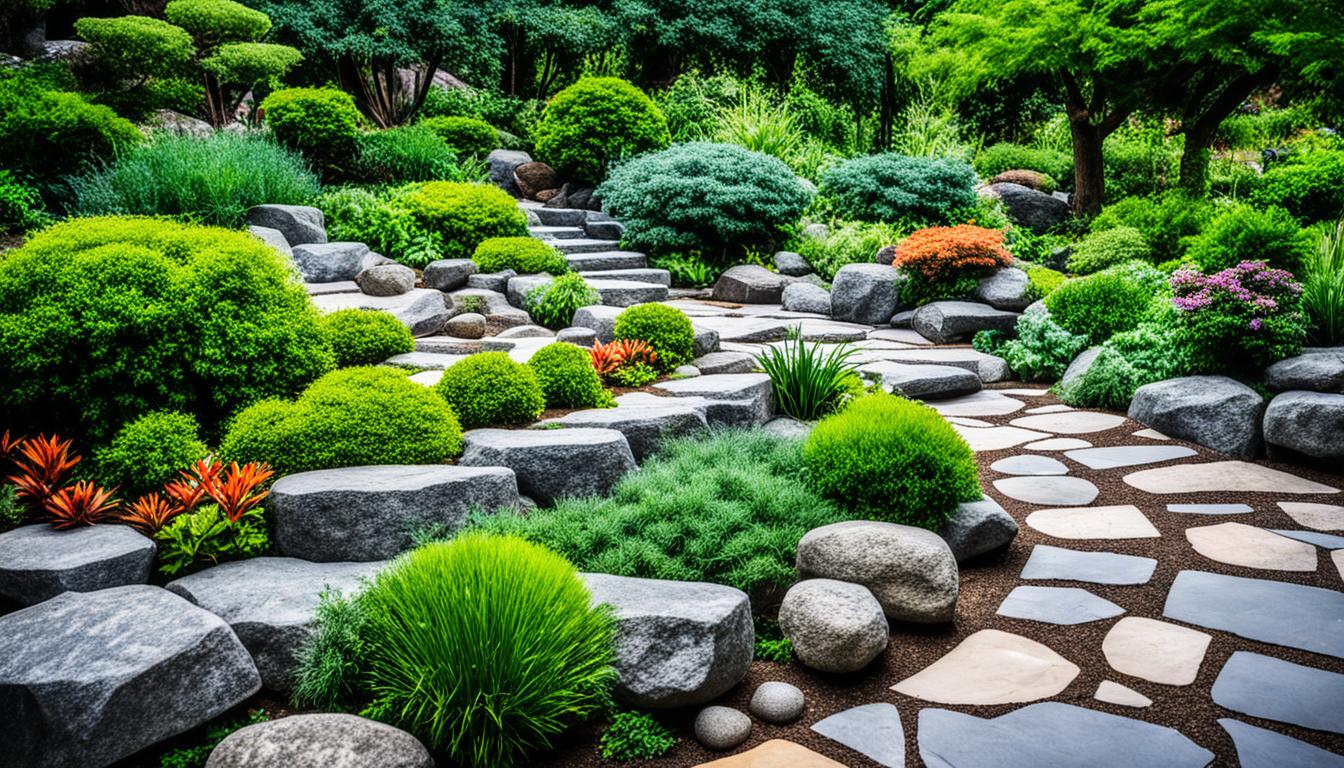Hello, I’m thrilled to share some exciting ideas and inspiration for creating beautiful rock gardens. Rock gardens have the power to transform your outdoor space into a stunning stone masterpiece. With their unique design possibilities and natural aesthetics, they can enhance the beauty and serenity of any landscape.
Whether you have a small backyard or a spacious front yard, rock gardens can be designed to fit any space. They offer numerous benefits, including low maintenance, durability, and excellent drainage, making them a wise choice for homeowners looking for an attractive yet low-maintenance outdoor feature.
In this article, I’ll explore a variety of creative ideas and designs for rock gardens. From incorporating different plants that thrive in rocky environments to utilizing various sizes and shapes of rocks for texture and visual interest, you’ll discover how to create a truly unique and stunning stone landscape.
Key Takeaways:
- Rock gardens can transform any outdoor space into a stunning stone masterpiece.
- They offer numerous benefits, including low maintenance and excellent drainage.
- Creative ideas for rock gardens include using different plants and rocks for texture and visual interest.
- There are various types of rock garden designs to choose from, including traditional Japanese rock gardens and English rock gardens.
- Proper planning, execution, and maintenance are essential for creating and maintaining a beautiful rock garden.
The Benefits of Rock Gardens
Rock gardens are a fantastic addition to any outdoor space, offering a range of benefits for homeowners. Not only do they provide a stunning and unique visual appeal, but they also require less maintenance compared to traditional gardens.
One of the primary advantages of rock gardens is their low-maintenance nature. They require less water and regular care, making them ideal for individuals with busy schedules or those looking to reduce their water usage. With rock gardens, you can spend less time tending to plants and more time enjoying your outdoor space.
Another benefit of rock gardens is their durability. Rocks are resilient and long-lasting, ensuring that your rock garden will maintain its beauty for years to come. They can withstand various weather conditions and do not require replacement or frequent maintenance.
Additionally, rock gardens offer excellent drainage capabilities. The rocks allow water to flow through them, preventing soil erosion and minimizing the risk of flooding. This makes rock gardens a practical choice for areas prone to heavy rainfall or poor drainage.
Furthermore, rock gardens can be designed to fit any space, whether you have a small backyard corner or a large front yard area. The versatility of rock garden design allows you to create a unique and personal outdoor space that complements your home’s architecture and landscape.
Overall, rock gardens provide a range of benefits, from their low-maintenance requirements to their durability and drainage capabilities. With the endless possibilities for rock garden design, you can create a stunning stone landscape that enhances the beauty of your outdoor space.
Creative Rock Garden Ideas
When it comes to rock gardens, the possibilities are endless for creating a unique and eye-catching landscape. Incorporating a variety of rock garden plants, utilizing different construction techniques, and drawing inspiration from nature can result in a stunning rock garden design that stands out. Here are some creative rock garden ideas to inspire your landscaping project.
1. Diverse Plant Selection
One of the key elements in a rock garden is the choice of plants. Consider incorporating a mix of rock garden plants that thrive in rocky environments. Succulents, such as sedums and hens and chicks, are excellent choices as they are low-maintenance and add a pop of color. Alpine plants, like alpine phlox and mountain avens, are perfect for creating an alpine-inspired rock garden. Ornamental grasses, such as blue fescue and pink muhly, can add texture and movement to your landscape.
2. Play with Rock Sizes and Shapes
Add visual interest and dimension to your rock garden by using rocks of different sizes and shapes. Large boulders can serve as focal points and anchor the overall design, while smaller rocks fill in gaps and add texture. Pro Tip: Place rocks strategically to create a sense of naturalness, as if the rocks were there organically.
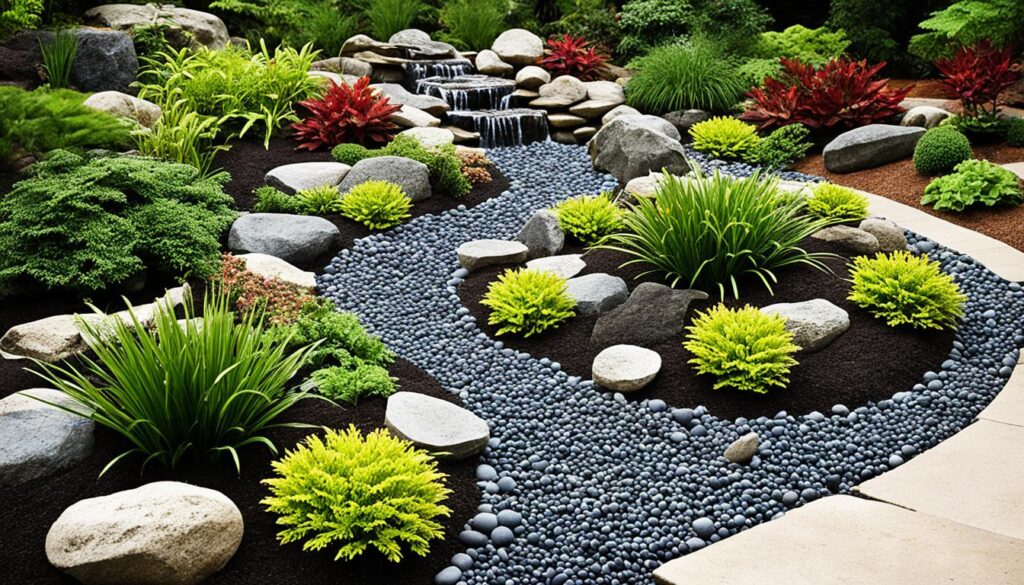
3. Create Terraced Rock Gardens
If you have sloping terrain, consider creating terraced rock gardens. This construction technique not only makes use of the natural incline but also provides opportunities to add depth and layers to your landscape. Each terrace can feature different plants and rocks, allowing for a unique and cascading effect.
4. Draw Inspiration from Natural Rock Formations
When designing your rock garden, look to natural rock formations for inspiration. Rugged cliffs, serene waterfalls, and meandering streams can all serve as sources of inspiration. By replicating these natural elements, you can create a rock garden that feels harmonious and blends seamlessly with its surroundings.
5. Unique Elements
Adding unique elements to your rock garden can take your design to the next level. Consider incorporating water features, such as a small cascading fountain or a tranquil pond, to create a soothing atmosphere. Sculptures, stepping stones, or even a cozy seating area can also add personality and charm to your rock garden.
By combining creative rock garden plants, unique construction techniques, and drawing inspiration from nature, you can design a rock garden that is truly one-of-a-kind. Let your imagination soar and bring your vision to life with a stunning rock garden.
Natural Stone Landscaping
Natural stone is a popular choice for rock gardens, as it provides a natural and organic look. There are many types of natural stone to choose from, including granite, limestone, and sandstone, each with its own unique colors and textures. Natural stone can be used to create pathways, borders, and focal points in your rock garden. It can also be used to build retaining walls, adding structure and elevation to your landscape. Natural stone landscaping is versatile and can be adapted to suit different styles and preferences.
When selecting natural stone for your rock garden, consider the overall aesthetic you want to achieve. Granite rocks, with their rugged texture and varying shades of gray, can create a contemporary and elegant look. Limestone rocks, with their light and warm tones, add a softer and more inviting touch. Sandstone rocks, with their rich and earthy colors, evoke a sense of warmth and natural beauty.
If you’re looking to create a cohesive and harmonious rock garden, consider using the same type of natural stone throughout the design. This will create a unified and visually pleasing look. Alternatively, you can mix and match different types of natural stone for a more eclectic and visually dynamic rock garden.
Here’s a comparison table showcasing the different types of natural stone and their characteristics:
| Stone Type | Colors | Textures | Characteristics |
|---|---|---|---|
| Granite | Gray, black, white | Rugged, coarse | Durable and weather resistant |
| Limestone | Beige, cream, yellow | Smooth, soft | Soft and porous |
| Sandstone | Red, brown, yellow | Grainy, textured | Rich in color and texture |
Experiment with different sizes and shapes of natural stone to create visual interest and texture in your rock garden. Larger stones can serve as focal points or anchor points, while smaller stones can be used to fill in gaps and create a seamless design.
Remember to position your natural stones strategically to create a sense of flow and movement in your rock garden. Play with different arrangements and orientations to find the most visually pleasing layout.
Overall, natural stone landscaping offers a wide range of possibilities for creating a stunning rock garden. Whether you prefer a modern and sleek design or a rustic and natural look, natural stone can help you achieve your desired aesthetic. Embrace the beauty of nature and let natural stone elevate your backyard rock garden to new heights.
Types of Rock Garden Designs
When it comes to rock garden designs, there are several styles to choose from. Each style offers its own unique charm and appeal, allowing you to create a rock garden that perfectly suits your taste and vision. Let’s explore some popular rock garden designs:
Traditional Japanese Rock Gardens
Traditional Japanese rock gardens, also known as Zen gardens, are celebrated for their simplicity and minimalism. These gardens often feature large rocks strategically placed in a sea of white sand or gravel, representing islands or mountains in a tranquil landscape. The careful arrangement of rocks and the use of minimal plants create a sense of harmony and tranquility.
English Rock Gardens
English rock gardens embrace a more naturalistic approach and blend seamlessly with the surrounding landscape. They incorporate a mix of rocks, plants, and water features to create a harmonious and picturesque scene. The combination of flowing water, vibrant plants, and natural stone elements provides a stunning, serene ambiance.
Alpine Gardens
Alpine gardens focus on showcasing plants that thrive in high-altitude or rocky environments, such as alpine perennials, succulents, and dwarf shrubs. These gardens often feature stacked rocks or terraces to simulate mountainous regions. The careful selection of plants and the strategic placement of rocks create a beautiful and authentic alpine landscape.
Modern Rock Gardens
Modern rock gardens take a contemporary approach to design, incorporating sleek lines and minimalist elements. They often feature geometric patterns, clean edges, and a limited color palette. The use of large, bold rocks and carefully placed plants creates a visually striking and sophisticated rock garden.
Desert Rock Gardens
Desert rock gardens draw inspiration from arid landscapes, incorporating desert-adapted plants and natural stone elements. These gardens typically feature cacti, succulents, and drought-tolerant plants, combined with native desert rocks and sand. The carefully designed desert rock garden showcases the beauty of arid environments and creates a unique oasis in your outdoor space.
These are just a few examples of rock garden designs, each offering its own distinct style and ambiance. Choose the design that speaks to you and aligns with your overall landscaping vision. Let your creativity flow and transform your outdoor space into a stunning rock garden that truly reflects your personal style.
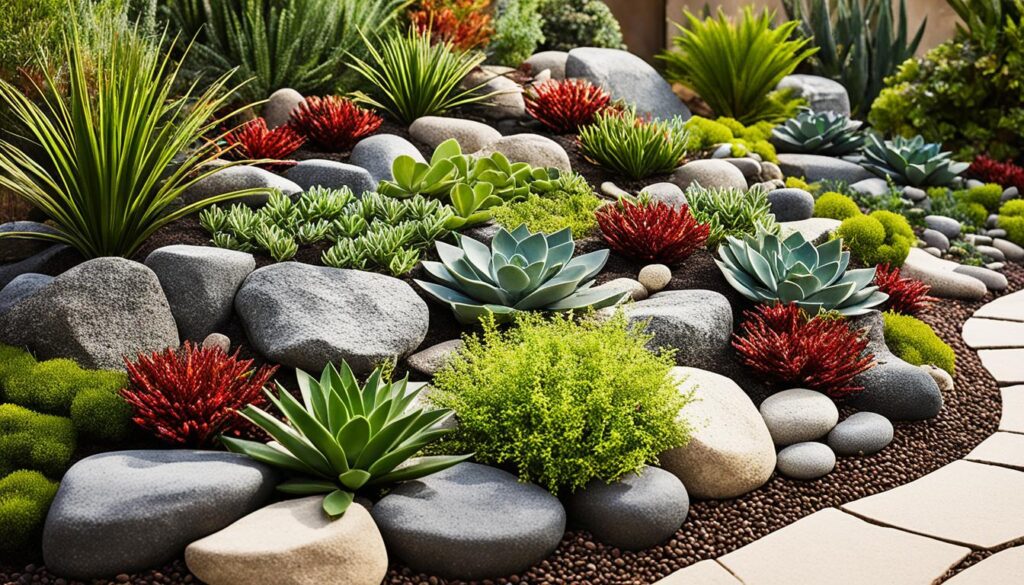
Comparing Rock Garden Designs
| Traditional Japanese | English | Alpine | Modern | Desert | |
|---|---|---|---|---|---|
| Design Elements | Simplicity, minimalism, large rocks, white sand/gravel | Naturalistic, flowing water, vibrant plants, natural stone | Mountainous terrain, stacked rocks, alpine perennials | Sleek lines, minimalist, geometric patterns | Desert-adapted plants, native rocks, sand |
| Plant Selection | Minimal plants, Zen-inspired | Variety of plants, blending with surroundings | Alpine perennials, succulents, dwarf shrubs | Carefully chosen plants | Cacti, succulents, drought-tolerant plants |
| Color Palette | Neutral colors, white sand/gravel | Natural colors, vibrant flowers | Varied colors, alpine plant hues | Minimal color palette | Earthy tones, desert-inspired |
| Ambiance | Tranquil, serene | Picturesque, harmonious | Authentic alpine landscape | Sophisticated, contemporary | Desert oasis |
Tips for Creating a Stunning Rock Garden
Creating a stunning rock garden requires careful planning and execution. Here are some tips to help you create a rock garden that will truly stand out:
1. Study the Natural Landscape
Before starting your rock garden construction, take the time to study the natural landscape of your yard. Observe the terrain, soil conditions, and sunlight exposure in different areas. This will help you determine the best location for your rock garden and ensure that it integrates seamlessly into the existing environment.
2. Prepare the Site
Prepare your rock garden site by removing any existing vegetation and leveling the ground. This will provide a clean canvas for your design and make it easier to lay down the rocks and plants. Use a shovel and rake to clear the area and create a smooth surface.
3. Choose Rocks and Plants
Choose rocks and plants that are suitable for your climate and match your desired aesthetic. Consider the size, shape, and color of the rocks to create visual interest and texture. Select plants that thrive in rocky environments, such as succulents, alpine plants, and ornamental grasses. The combination of rocks and plants will create a harmonious and visually appealing composition.
4. Pay Attention to Spacing and Placement
Pay attention to the spacing and placement of rocks and plants in your rock garden. Create a balanced and visually pleasing arrangement by varying the sizes and shapes of the rocks. Consider using taller rocks as focal points and filling in the gaps with smaller rocks and plants. This will create depth and dimension in your rock garden design.
5. Add Finishing Touches
Add finishing touches to complete the look of your rock garden. Consider adding mulch, gravel, or ground cover plants between the rocks to fill in the spaces and create a cohesive look. These elements will not only enhance the aesthetic appeal but also help with weed control and moisture retention.
“A well-designed rock garden can bring beauty and tranquility to any outdoor space.”
By following these tips, you can create a stunning rock garden that will be the envy of your neighbors. Take the time to plan and execute your design carefully, and enjoy the beauty of your rock garden for years to come.
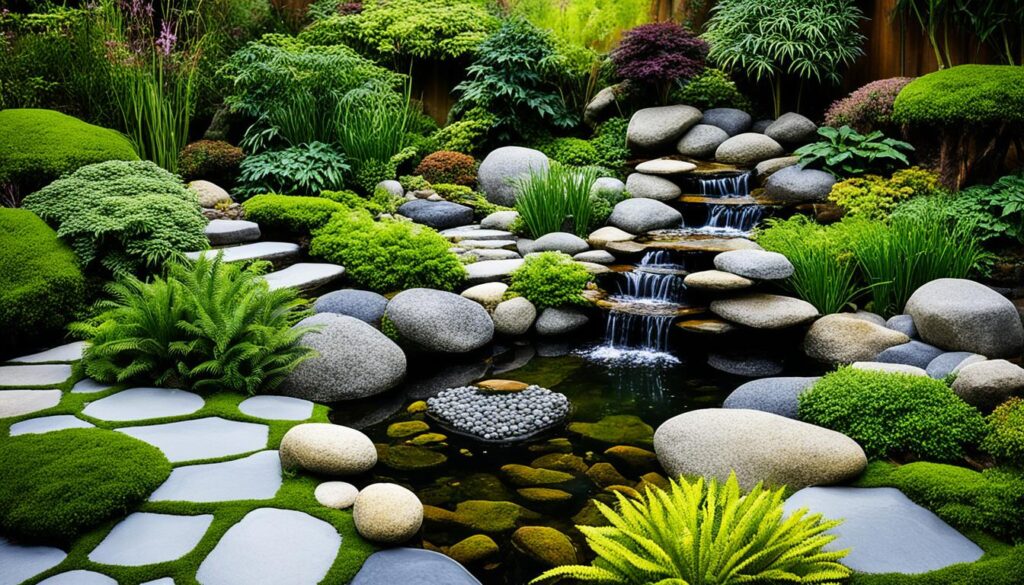
| Rock Garden Tips | Description |
|---|---|
| Study the Natural Landscape | Observe the terrain, soil conditions, and sunlight exposure to determine the best location. |
| Prepare the Site | Remove existing vegetation and level the ground for a clean canvas. |
| Choose Rocks and Plants | Select rocks and plants suitable for your climate and desired aesthetic. |
| Pay Attention to Spacing and Placement | Create a visually pleasing arrangement by varying the sizes and shapes of the rocks. |
| Add Finishing Touches | Complete the look with mulch, gravel, or ground cover plants. |
Maintaining Your Rock Garden
While rock gardens require less maintenance compared to traditional gardens, they still need regular care to stay healthy and beautiful. Here are some essential maintenance tips to keep your rock garden thriving:
1. Weed Control
Remove any weeds or unwanted plants that may try to invade your rock garden. Weeds not only compete with your desired plants for nutrients and water but can also spoil the overall aesthetic of your garden.
2. Pruning and Trimming
Trim and prune plants as necessary to maintain their shape and prevent overgrowth. This will help promote healthy growth and ensure that your rock garden plants remain visually appealing.
3. Pest and Disease Management
Keep an eye out for pests or diseases that may affect your plants. Regularly inspect your rock garden for any signs of pest infestation or disease symptoms such as wilting leaves, discoloration, or unusual growth. Take appropriate measures to treat or prevent these issues to protect your plants.
4. Rock Maintenance
Check the condition of the rocks in your rock garden and make any necessary repairs or replacements. Over time, rocks may shift or become damaged due to weather conditions or other factors.
5. Proper Watering
Regularly water your rock garden, taking care not to overwater as it can lead to root rot. Watering requirements will vary depending on the specific plants in your rock garden, but generally, deep watering once a week is sufficient.
6. Mulching and Ground Cover
Add a layer of mulch or ground cover plants around your rock garden to help conserve moisture, suppress weed growth, and enhance the overall appearance of your garden.
By following these maintenance tips, you can ensure that your rock garden remains a beautiful and thriving focal point in your landscape.
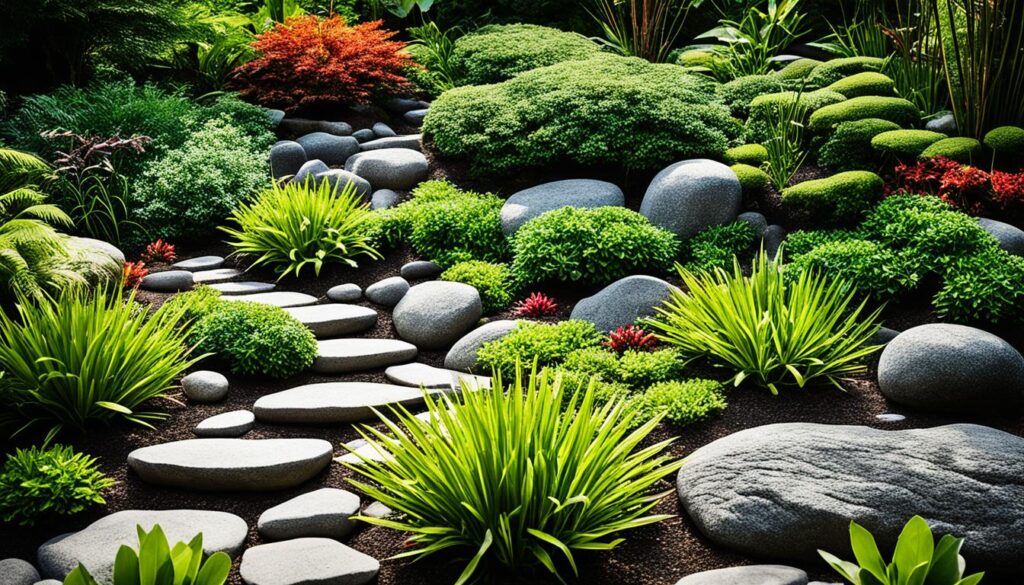
| Common Maintenance Tasks | Frequency |
|---|---|
| Weed control | As needed |
| Pruning and trimming | Ongoing, as necessary |
| Pest and disease management | Ongoing, regular inspections |
| Rock maintenance | Ongoing, as needed |
| Proper watering | Once a week, or as needed |
| Mulching and ground cover | Periodically, as needed |
Inspiration for Stunning Stone Landscapes
To inspire your rock garden design, here are some stunning stone landscapes from around the world:
The Hanging Gardens of Babylon
The Hanging Gardens of Babylon in ancient Mesopotamia are a prime example of a magnificent stone landscape.
The Rock Gardens of Ryoan-ji Temple
The rock gardens of Ryoan-ji Temple in Kyoto, Japan, showcase the simplicity and elegance of Zen rock gardens.
The Butchart Gardens
The Butchart Gardens in British Columbia, Canada, feature beautifully designed rock gardens integrated with colorful flowers and plants.
Draw inspiration from these iconic landscapes to create your own unique and breathtaking stone landscape.
Conclusion
Rock gardens offer endless possibilities for creative and stunning stone landscapes. With their unique blend of rocks, plants, and design elements, they allow you to create a personalized outdoor space that reflects your style and personality. Whether you prefer the timeless elegance of a traditional rock garden or the sleek and modern look of a contemporary design, there are countless options to choose from.
Creating a rock garden requires careful planning, execution, and maintenance. By considering factors such as soil conditions, sunlight exposure, and drainage, you can ensure that your rock garden thrives. Choose rocks and plants that are suitable for your climate and match your desired aesthetic. Pay attention to spacing and placement to achieve a visually appealing composition. With proper care, your rock garden will become a beautiful focal point in your landscape, providing you with years of enjoyment.
So why wait? Reimagine your outdoor space and let your creativity soar. Take inspiration from nature and iconic stone landscapes around the world. Experiment with different rock sizes, shapes, and colors. Explore various plant options and incorporate unique design elements. With a well-designed and carefully constructed rock garden, you can transform your ordinary landscape into a breathtaking masterpiece that leaves a lasting impression.
FAQ
What are the benefits of having a rock garden?
Rock gardens are low-maintenance, durable, and provide great drainage. They can be designed to fit any space and offer endless creative possibilities.
What plants are suitable for rock gardens?
Plants that thrive in rocky environments, such as succulents, alpine plants, and ornamental grasses, are ideal for rock gardens.
How do I construct a rock garden?
To construct a rock garden, start by studying the natural landscape and determining the best location. Remove existing vegetation, level the ground, choose appropriate rocks and plants, and pay attention to spacing and placement.
What are some popular rock garden designs?
Popular rock garden designs include traditional Japanese Zen gardens, English rock gardens, alpine gardens, modern rock gardens, and desert rock gardens.
How do I maintain a rock garden?
Regular maintenance includes removing weeds, trimming and pruning plants, checking for pests or diseases, and inspecting the condition of rocks. Proper watering is also important.
Can I get inspiration for my rock garden design?
Absolutely! Draw inspiration from stunning stone landscapes such as the Hanging Gardens of Babylon, the rock gardens of Ryoan-ji Temple, and the Butchart Gardens.

